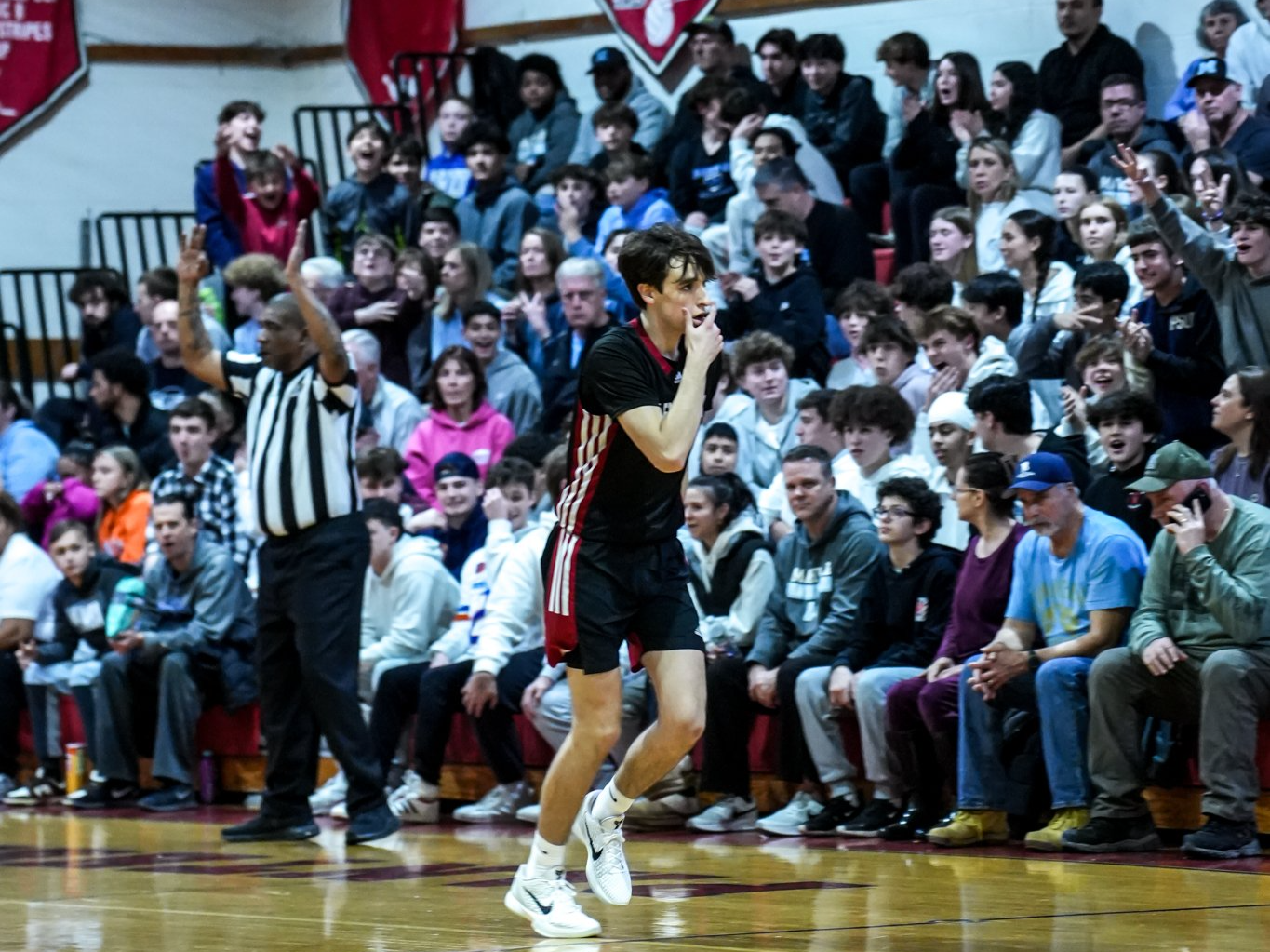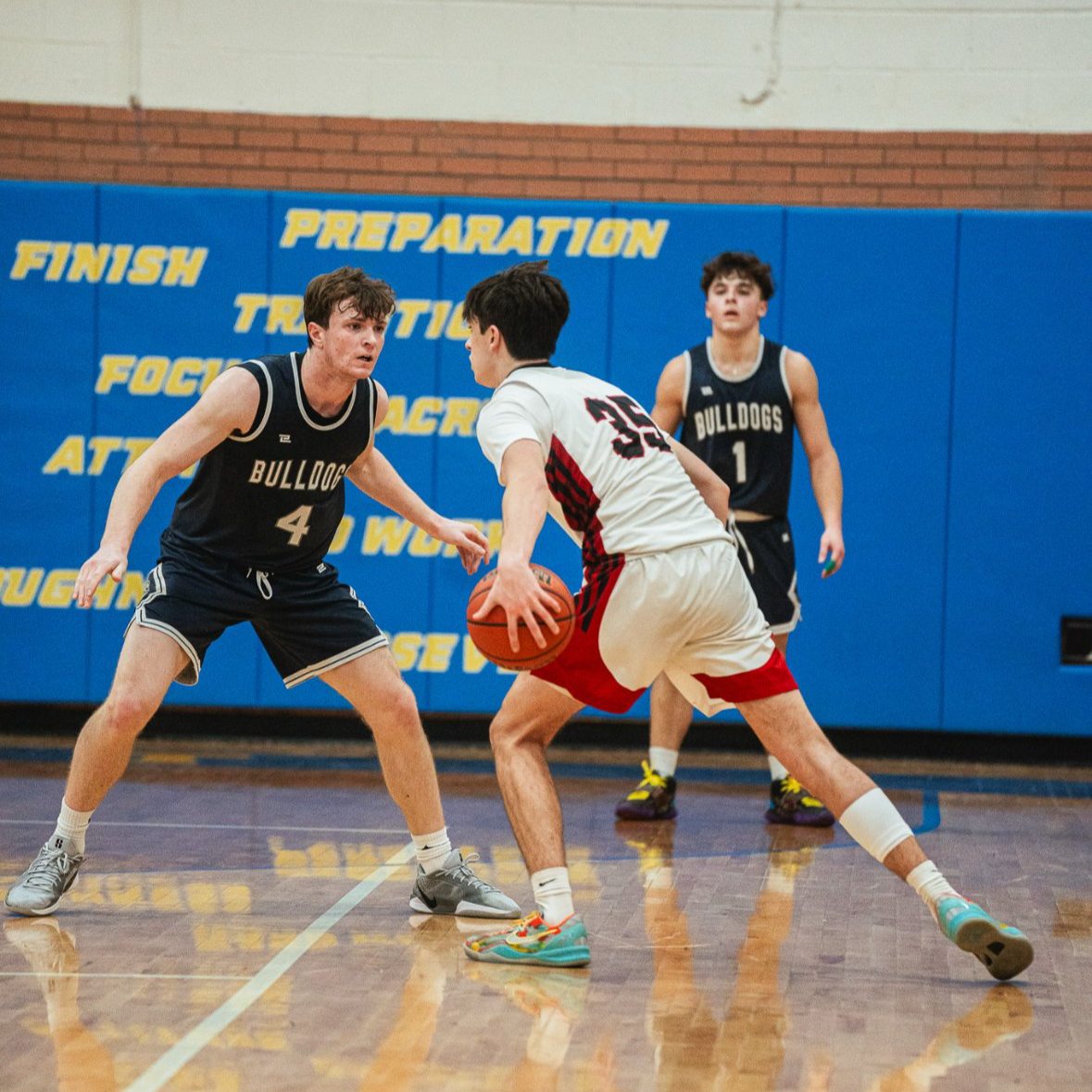Mason Mangione: “Becoming a Great Shooter Isn’t Something That Happens Overnight”
Glen Rock’s Mason Mangione celebrates a made field goal. Photo provided by Mason Mangione.
I’ve always wanted to get inside the minds of great shooters, to understand what makes them great.
So when I got the opportunity to interview Mason Mangione, Glen Rock High School’s all-time leading scorer and one of the best shooters in Bergen County this past season, I was curious to get his perspective.
My main takeaway, which is obvious, but bears repeating is this: there are no shortcuts.
“Becoming a great shooter isn’t something that happens overnight,” Mason said, stressing the value of hard work and patience to his success. “You have to put in a lot of hours into shooting and know you’re doing the right work, and it’ll happen over time.”
Humble Beginnings
Mason’s basketball journey didn’t get off to the most auspicious start. He recalled that the first time his Mom dropped him off at a Pre-K clinic for the Goats/Silverbacks program, “I hated it. I started crying. I wanted to leave, but my Mom and Coach Jeff Graham made me stay.”
After that first session, Mason fell in love with basketball, but he acknowledged that “I wasn’t really good growing up. I wasn’t the best kid in my grade.” And when it came to shooting, he said, “I was a fine shooter but there were always better shooters around me. To get power, I would cross my hands over, to shoot with both hands.”
Good to Great
Mason’s transformation as a shooter and overall player began in 7th and 8th grades, during Covid. “While a lot of other kids were sitting at home, I was playing pretty much every day,” he said. Mason wasn’t shooting a lot of three pointers like many younger players love to do. His goal was to fix his two-handed shot, so he worked on perfecting his mechanics by form shooting close to the basket and then backing up from there.
Mason credited Ramapo Head Coach Nick Vier with helping him with his shot technique during this time. Said Coach Vier: “Mason’s always been a step slow and so he had to learn at a young age how to use very good footwork and play off the ball to get open shots. I think that’s what has made him such a good player as his body developed and he has gotten stronger and faster.”
While playing for Glen Rock’s freshman team, however, Mason found it difficult to gauge his progress against the inferior competition his team faced that season. So between his freshman and sophomore years, Mason said he worked his tail off under the guidance of Coach Albert Aroyo at North Eastern Sports in Clifton. “I found out what hard work was when I met Coach Albert,” Mason said.
Sophomore year is when Mason noticed that his hard work as a shooter was beginning to pay off. He was inserted into the varsity starting lineup along with four seniors. Head Coach Jason Mittelman expected him to shoot, and Mason delivered, connecting on 55 threes and averaging 13.2 points per game.
Most of Mason’s shots were of the catch and shoot variety since he said, “I didn’t really have the handle or the size to get to the basket.”
Now that the secret was out about Mason’s shooting prowess, he knew that opposing teams were going to run him off the three-point line his junior season. He had to learn how to score off the dribble and from different areas on the floor.
Mason’s Approach to Shooting
Mason displays his lethal shooting form. Photo provided by Mason Mangione.
Like snowflakes, no two great shooter are exactly alike, either in their shooting form or approach. A Steph Curry jump shot does not look the same as a Ray Allen or Reggie Miller jump shot even though they are all effective.
The thing that matters is, does it work? For Mason, who shot around 38% on threes, the answer is unequivocally yes.
Besides getting a ton of reps, Mason described a few things that allowed him to continue growing as a shooter in high school:
Shooting off the move. According to Mason, most threes in a game are off the move, unless you’re only a spot up shooter. Plus, “if you can shoot off the move,” Mason said, “you can shoot stand still [as well].” Mason’s Glen Rock team ran a fast break offense and Mason would often sprint to the right corner for an open three, so sprinting into his shots in practice helped him to replicate game conditions. It also built his conditioning.
One of Mason’s favorite shooting drills is called the star drill, which he used with Coach Jeff Graham. It required him to sprint to five different spots on the court that formed a star, shooting one shot at each spot, then immediately sprint to the other side of the court and do the same thing. His goal was to hit all ten shots.
Prioritizing the body’s natural motion and consistency over the “perfect” form. “I don’t really believe in having a picture perfect form,” Mason said. “I have a nice looking shot; it’s not perfect. People think it’s not right to flick your thumb. I do that and I do all right. Do whatever you feel comfortable with and whatever feels right and get a ton of reps.”
Also, when it comes to rotation on the ball and arc, Mason said he doesn’t overthink it, unless he misses a few in a row and has to adjust.
Balance and footwork are essential. “No matter where you are, whether it’s mid-range, three pointer, catch and shoot, off the dribble, whatever it is, as long as you’re on balance and shooting your shot, it’s a good shot,” Mason said. He also emphasized the importance of practicing different footwork into your shot whether it’s a one-two step (inside-outside or outside-inside) or off the hop.
“Next shot” mentality. “Whether I’m really hot or cold, I’m just thinking ‘next shot’,” Mason said. “I’m not worried about the previous one. I’m just controlling the present and not worrying about the past.”
This mentality did not come right away. Mason acknowledged that during his sophomore year, after a few misses in a row, “I’d have very poor body language and wouldn’t be playing defense. I’d just take myself out of the game.” But by senior year, with the support of Coach Mittelman, “no matter how bad I was shooting it, I was contributing in other ways – defense, rebounding, and passing the ball,” Mason said.
Mason also said that his confidence in games came from knowing that he had put in the work in practice.
Working on a quicker shot release. Mason has the benefit of being 6’3” with a high release point. However, because he was being hounded by opposing defenders, he consciously practiced getting his shot off quicker without sacrificing form. According to his childhood trainer Nick Vier, who has admired Mason’s progress over the years, this quicker shot release is the result of Mason’s “exceptional” footwork and shot preparation.
Mason was also forced to extend his range. He said that upper body weight lifting allowed him to get stronger for that.
Senior Year: Putting It All Together
To Mason, an effective shooter is someone who can score not only behind the three point line but also in the mid range and at the basket. (Kevin Durant is Mason’s favorite player for this reason.)
Senior year was when Mason’s ability to score efficiently at all three levels finally came together. And he had to do it all while being face guarded by the opposing defense nearly every game. Mason said that, although he’s not the fastest athlete, his stamina and the team setting a lot of screens helped him get open.
Mason’s shot distribution tells the tale. As a sophomore, 51% of Mason’s made field goals were three pointers; senior year, Mason still made a lot of threes but they only comprised 39% of his makes. He also got to the free throw line a lot more frequently, demonstrating his aggressiveness.
Mason said that his best shooting performances, when every shot felt like it was going in, occurred early in his senior season. During the annual Ridgewood Holiday Tournament, Mason had 38 points against Ridgewood and then poured in 39 against Pascack Valley.
Said Pascack Vally’s Devin Merker, who was also teammates with Mason on their AAU team NJ Beasts: “Mason is hands down the best shooter I’ve played with. Once he hits one, you know the other team is in trouble.”
Mason showing improvement attacking the basket. Photo provided by Mason Mangione.
With Mason leading the way, Glen Rock would go onto win sectionals in the state playoffs, which hadn’t happened for over 50 years.
Shooting the basketball has become more important than ever in today’s game. But as Mason reflected on his basketball journey, I asked him if he had any additional advice for younger players: “Don’t just be a shooter,” he said. “Even when you become a great shooter, you have to work on other things. If I hadn’t, I wouldn’t have been the player I was.”



